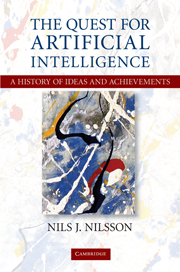Book contents
- Frontmatter
- Contents
- Preface
- PART I BEGINNINGS
- 1 Dreams and Dreamers
- 2 Clues
- PART II EARLY EXPLORATIONS: 1950S AND 1960S
- PART III EFFLORESCENCE: MID-1960S TO MID-1970S
- PART IV APPLICATIONS AND SPECIALIZATIONS: 1970s TO EARLY 1980s
- PART V “NEW-GENERATION” PROJECT
- PART VI ENTR'ACTE
- PART VII THE GROWING ARMAMENTARIUM: FROM THE 1980s ONWARD
- PART VIII MODERN AI: TODAY AND TOMORROW
- Index
- Plate section
2 - Clues
Published online by Cambridge University Press: 05 August 2013
- Frontmatter
- Contents
- Preface
- PART I BEGINNINGS
- 1 Dreams and Dreamers
- 2 Clues
- PART II EARLY EXPLORATIONS: 1950S AND 1960S
- PART III EFFLORESCENCE: MID-1960S TO MID-1970S
- PART IV APPLICATIONS AND SPECIALIZATIONS: 1970s TO EARLY 1980s
- PART V “NEW-GENERATION” PROJECT
- PART VI ENTR'ACTE
- PART VII THE GROWING ARMAMENTARIUM: FROM THE 1980s ONWARD
- PART VIII MODERN AI: TODAY AND TOMORROW
- Index
- Plate section
Summary
Clues about what be needed to make machines intelligent are scattered abundantly throughout philosophy, logic, biology, psychology, statistics, and engineering. With gradually increasing intensity, people set about to exploit clues from these areas in their separate quests to automate some aspects of intelligence. I begin my story by describing some of these clues and how they inspired some of the first achievements in artificial intelligence.
From Philosophy and Logic
Although people had reasoned logically for millennia, it was the Greek philosopher Aristotle who first tried to analyze and codify the process. Aristotle identified a type of reasoning he called the syllogism “… in which, certain things being stated, something other than what is stated follows of necessity from their being so.”
Here is a famous example of one kind of syllogism:
All humans are mortal. (stated)
All Greeks are humans. (stated)
All Greeks are mortal. (result)
The beauty (and importance for AI) of Aristotle's contribution has to do with the form of the syllogism. We aren't restricted to talking about humans, Greeks, or mortality. We could just as well be talking about something else – a result made obvious if we rewrite the syllogism using arbitrary symbols in the place of humans, Greeks, and mortal. Rewriting in this way would produce
All B's are A. (stated)
All C's are B's. (stated)
All C's are A. (result)
One can substitute anything one likes for A, B, and C. For example, all athletes are healthy and all soccer players are athletes, and therefore all soccer players are healthy, and so on.
- Type
- Chapter
- Information
- The Quest for Artificial Intelligence , pp. 10 - 46Publisher: Cambridge University PressPrint publication year: 2009



